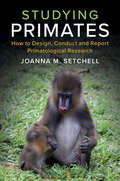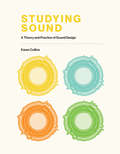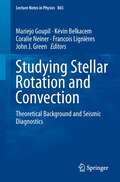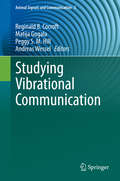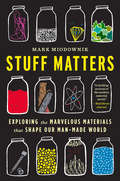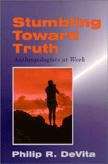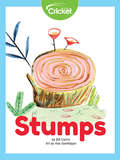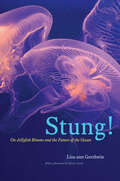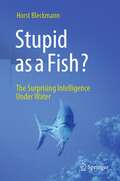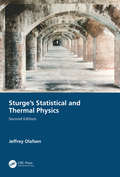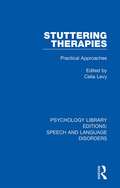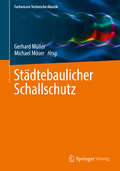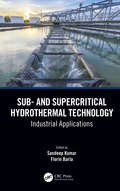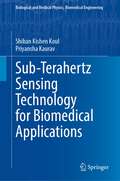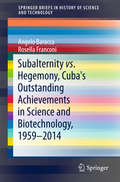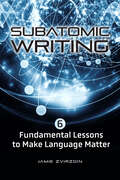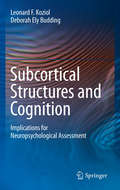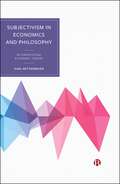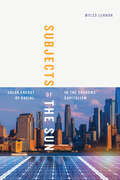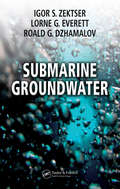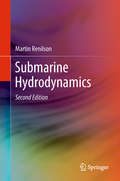- Table View
- List View
Studying Primates: How to Design, Conduct and Report Primatological Research
by Joanna M. SetchellPrimatology draws on theory and methods from diverse fields, including anatomy, anthropology, biology, ecology, medicine, psychology, veterinary sciences and zoology. The more than 500 species of primate range from tiny mouse lemurs to huge gorillas, and primatologists collect data in a variety of environments including in the field, research facilities, museums, sanctuaries, zoos, and from the literature. The variability in research interests, study animals and research sites means that there are no standard protocols for how to study primates. Nevertheless, asking good questions and designing appropriate studies to answer them are vital to produce high quality science. This accessible guide for graduate students and post-doctoral researchers explains how to develop a research question, formulate testable hypotheses and predictions, design and conduct a project and report the results. The focus is on research integrity and ethics throughout, and the book provides practical advice on overcoming common difficulties researchers face.
Studying Sound: A Theory and Practice of Sound Design
by Karen CollinsAn introduction to the concepts and principles of sound design practice, with more than 175 exercises that teach readers to put theory into practice.This book offers an introduction to the principles and concepts of sound design practice, from technical aspects of sound effects to the creative use of sound in storytelling. Most books on sound design focus on sound for the moving image. Studying Sound is unique in its exploration of sound on its own as a medium and rhetorical device. It includes more than 175 exercises that enable readers to put theory into practice as they progress through the chapters.
Studying Stellar Rotation and Convection
by John J. Green Coralie Neiner Kévin Belkacem Francois Lignières Mariejo GoupilThis volume synthesizes the results of work carried out by several international teams of the SIROCO (Seismology for Rotation and Convection) collaboration. It provides the theoretical background required to interpret the huge quantity of high-quality observational data recently provided by space experiments such as CoRoT and Kepler. Asteroseismology allows astrophysicists to test, to model and to understand stellar structure and evolution as never before. The chapters in this book address the two groups of topics summarized as "Stellar Rotation and Associated Seismology" as well as "Stellar Convection and Associated Seismology". The book offers the reader solid theoretical background knowledge and adapted seismic diagnostic techniques.
Studying Vibrational Communication
by Reginald B. Cocroft Matija Gogala Peggy S.M. Hill Andreas WesselThis volume explains the key ideas, questions and methods involved in studying the hidden world of vibrational communication in animals. The authors dispel the notion that this form of communication is difficult to study and show how vibrational signaling is a key to social interactions in species that live in contact with a substrate, whether it be a grassy lawn, a rippling stream or a tropical forest canopy. This ancient and widespread form of social exchange is also remarkably understudied. A frontier in animal behavior, it offers unparalleled opportunities for discovery and for addressing general questions in communication and social evolution. In addition to reviews of advances made in the study of several animal taxa, this volume also explores topics such as vibrational communication networks, the interaction of acoustic and vibrational communication, the history of the field, the evolution of signal production and reception and establishing a common vocabulary.
Studying the Development and Reproduction of Organisms, Student Guide
by National Science Resources Center Amy Charles Max-Karl WinklerNIMAC-sourced textbook
Stuff Matters: Exploring the Marvelous Materials That Shape Our Man-Made World
by Mark MiodownikAn eye-opening adventure deep inside the everyday materials that surround us, packed with surprising stories and fascinating science<P> Why is glass see-through? What makes elastic stretchy? Why does a paper clip bend? Why does any material look and behave the way it does? These are the sorts of questions that Mark Miodownik is constantly asking himself. A globally-renowned materials scientist, Miodownik has spent his life exploring objects as ordinary as an envelope and as unexpected as concrete cloth, uncovering the fascinating secrets that hold together our physical world.<P> In Stuff Matters, Miodownik entertainingly examines the materials he encounters in a typical morning, from the steel in his razor and the graphite in his pencil to the foam in his sneakers and the concrete in a nearby skyscraper. He offers a compendium of the most astounding histories and marvelous scientific breakthroughs in the material world, including:<P> The imprisoned alchemist who saved himself from execution by creating the first European porcelain.<P> The hidden gem of the Milky Way, a planet five times the size of Earth, made entirely of diamond.<P> Graphene, the thinnest, strongest, stiffest material in existence—only a single atom thick—that could be used to make entire buildings sensitive to touch.<P> From the teacup to the jet engine, the silicon chip to the paper clip, the plastic in our appliances to the elastic in our underpants, our lives are overflowing with materials. Full of enthralling tales of the miracles of engineering that permeate our lives, Stuff Matters will make you see stuff in a whole new way.
Stumbling Toward Truth: Anthropologists at Work
by Philip R. DevitaThe essayists in Stumbling Toward Truth are anthropologists who have paused to share personal experiences that uncover important truths they've learned by living with and trying to understand others. The twenty-nine poignant fieldwork tales collected here reveal much about what anthropology can teach about others as well as ourselves, the spirit of the ethnographic enterprise, and issues of cross-cultural humanity and humaneness. Readers will discover from these once-private stories from around the world that much of what anthropologists learn about themselves and others is totally unanticipated. Oftentimes, cultural truths and unexpected realities are stumbled upon. These lessons, none for which social science training offered adequate preparation, remain perhaps the most memorable and critical of fieldwork.
Stumps
by Ana Sanfelippo Bill CairnsA tree’s rings can tell us many things about its long life–whether it was healthy, or unhealthy, if it needed rain or if its wide rings show it grew healthy and strong. Through poetry, this story shares the life of a tree and how special these giant plants really are! Find a stump and count the rings to listen to a tree’s story. Will the tree you pick be healthy? How will you know?
Stung!: On Jellyfish Blooms and the Future of the Ocean
by Lisa-ann Gershwin“The world of jellyfish is brought alive as you never imagined it could be by Lisa-ann Gershwin in this engaging, gripping, and often funny book.” —Callum Roberts, author of The Ocean of LifeAs our oceans become increasingly inhospitable to life, there is one creature that is thriving in this seasick environment: the beautiful, dangerous, and now incredibly numerous jellyfish. As foremost jellyfish expert Lisa-ann Gershwin describes in Stung!, the jellyfish population bloom is highly indicative of the tragic state of the world’s ocean waters, while also revealing the incredible tenacity of these remarkable creatures.Despite their often dazzling appearance, jellyfish are simple creatures with simple needs: namely, fewer predators and competitors, warmer waters to encourage rapid growth, and more places for their larvae to settle and grow. In general, oceans that are less favorable to fish are more favorable to jellyfish, and these are the very conditions that we are creating through mechanized trawling, habitat degradation, coastal construction, pollution, and climate change.Despite their role as harbingers of marine destruction, jellyfish are truly enthralling creatures in their own right, and in Stung!, Gershwin tells stories of jellyfish both attractive and deadly while illuminating many interesting and unusual facts about their behaviors and environmental adaptations. She takes readers back to the Proterozoic era, when jellyfish were the top predator in the marine ecosystem—at a time when there were no fish, no mammals, and no turtles; and she explores the role jellies have as middlemen of destruction, moving swiftly into vulnerable ecosystems. The story of the jellyfish, as Gershwin makes clear, is also the story of the world’s oceans, and Stung! provides a unique and urgent look at their inseparable histories—and future.
Stupid as a Fish?: The Surprising Intelligence Under Water
by Horst BleckmannCompared to mammals, fish are often underestimated and dismissed as less complex organisms. To refute this hasty conclusion, Horst Bleckmann presents to you the highly developed cognitive abilities of fish.Did you know, for example, that fish are the largest group of all vertebrates, with about 30,000 species, and that they colonize all aquatic habitats? For this immense feat, they have evolved a variety of highly specialized sensory systems and behaviors. According to recent research, fish also possess not only extremely sophisticated sensory organs, but also highly developed central nervous systems that are similar in basic structure to the brains of mammals.Immerse yourself in a fascinating world and learn all about the different sensory systems of fish. A concluding chapter additionally covers the global threat to fish from water pollution, cross-building in flowing waters, and the fishing industry.
Sturge's Statistical and Thermal Physics, Second Edition
by Jeffrey OlafsenThe original work by M.D. Sturge has been updated and expanded to include new chapters covering non-equilibrium and biological systems. This second edition re-organizes the material in a more natural manner into four parts that continues to assume no previous knowledge of thermodynamics. The four divisions of the material introduce the subject inductively and rigorously, beginning with key concepts of equilibrium thermodynamics such as heat, temperature and entropy. The second division focuses on the fundamentals of modern thermodynamics: free energy, chemical potential and the partition function. The second half of the book is then designed with the flexibility to meet the needs of both the instructor and the students, with a third section focused on the different types of gases: ideal, Fermi-Dirac, Bose-Einstein, Black Body Radiation and the Photon gases. In the fourth and final division of the book, modern thermostatistical applications are addressed: semiconductors, phase transitions, transport processes, and finally the new chapters on non-equilibrium and biological systems. Key Features: Provides the most readable, thorough introduction to statistical physics and thermodynamics, with magnetic, atomic, and electrical systems addressed alongside development of fundamental topics at a non-rigorous mathematical level Includes brand-new chapters on biological and chemical systems and non-equilibrium thermodynamics, as well as extensive new examples from soft condensed matter and correction of typos from the prior edition Incorporates new numerical and simulation exercises throughout the book Adds more worked examples, problems, and exercises
Stuttering Therapies: Practical Approaches (Psychology Library Editions: Speech and Language Disorders)
by Celia LevyOriginally published in 1987, this book presented new ideas on the treatment of stuttering, by leading authorities within Britain at the time. There are chapters on children and adolescents, as well as on adults. In each chapter the author describes the therapeutic approach, how it fits into general views on the nature of stuttering, the clients for which it is appropriate, and possible methods of evaluation. The book is aimed at speech therapists and psychologists and provided an important up-date of the subject for practitioners.
Städtebaulicher Schallschutz (Fachwissen Technische Akustik)
by Michael Möser Gerhard MüllerIn diesem Band der Reihe Fachwissen Technische Akustik werden die Beeinträchtigungen durch Umgebungslärm dargestellt und aus den Lärmwirkungen Zielwerte für den Lärmschutz abgeleitet. Die Methodik des städtebaulichen Lärmschutzes wird erläutert. Das aktuell gültige Immissionsschutzrecht wird beschrieben und bewertet. Für den Straßenverkehrslärm als relevanteste Quelle werden Instrumente und Maßnahmen zur Minderung vorgestellt.
Sub- and Supercritical Hydrothermal Technology: Industrial Applications
by Sandeep Kumar Florin BarlaSub- and Supercritical Hydrothermal Technology: Industrial Applications offers a practical view of a variety of industrial applications and their challenges, offering a deep understanding of the application of sub- and supercritical fluids and their techno-economic viability. This book covers a wide range of applications of hydrothermal processing that result in almost zero waste, high energy efficiency, sustainable chemical processes, and minimal impact over the life cycle. These applications include processing of hazardous waste, bioproducts, coal, lipids, heavy oil and bitumen, and carbon materials. The use of hot-compressed water instead of different organic solvents, such as methanol, acetone, and hexane, is an environmentally benign, green, and sustainable option which can help to design chemical processes that support green chemistry and engineering. This book is pertinent for researchers and professionals in the fields of chemical engineering, industrial chemistry, environmental engineering, materials engineering, and manufacturing.
Sub-Terahertz Sensing Technology for Biomedical Applications (Biological and Medical Physics, Biomedical Engineering)
by Shiban Kishen Koul Priyansha KauravThis book offers the readers an opportunity to acquire the concepts of artificial intelligence (AI) enabled sub-THz systems for novel applications in the biomedical field. The readers will also be inspired to contextualize these applications for solving real life problems such as non-invasive glucose monitoring systems, cancer detection and dental imaging. The introductory section of this book focuses on existing technologies for radio frequency and infrared sensing in biomedical applications, and their limited use in sensing applications, as well as the advantages of using THz technology in this context. This is followed by a detailed comparative analysis of THz electronics technology and other conventional electro optic THz setups highlighting the superior efficiency, affordability and portability of electronics-based THz systems. The book also discusses electronic sub-THz measurement systems for different biomedical applications. The chapters elucidate two major applications where sub-THz provides an edge over existing state of the art techniques used for non-invasive measurement of blood glucose levels and intraoperative assessment of tumor margins. There is a detailed articulation of an application of leveraging machine learning for measurement systems for non-invasive glucose concentration measurement. This helps the reader relate to the output in a more user-friendly format and understand the possible use cases in a more lucid manner. The book is intended to help the reader learn how to build tissue phantoms and characterize them at sub-THz frequencies in order to test the measurement systems. Towards the end of the book, a brief introduction to system automation for biomedical imaging is provided as well for quick analysis of the data. The book will empower the reader to understand and appreciate the immense possibilities of using electronic THz systems in the biomedical field, creating gateways for fueling further research in this area.
Subalternity vs. Hegemony, Cuba's Outstanding Achievements in Science and Biotechnology, 1959-2014
by Angelo Baracca Rosella FranconiThe present book introduces an original (new) perspective on Cuba. This book revisits Cuba's choice, after the 1959 revolution, to develop an advanced healthcare and scientific system. It also introduces new aspects of the problem development/underdevelopment. From the start, every effort of the Cuban leadership and scientific community was driven by the primary purpose of meeting the country's basic economic and social needs. Immediate key measures taken after the revolution included free education up to higher levels and free health services. In only a couple of decades Third World diseases were defeated and a First World health profile was achieved. In the sciences, support and collaboration was sought and welcomed from both Soviet and western countries. Moreover, due to the backward position of the Soviet Union in genetics and molecular biology, in the early 1970s Cuban scientists were trained in these fields mainly by Italian biologists. In the following decade, initially relying on contacts with American and Finnish specialists, Cuban biologists and physicians built a large industrial biotechnology complex to produce and commercialize Cuban-made, and often invented, medicines and vaccines. In the early 1990s the sudden collapse of the Soviet Union and the socialist market created an unprecedented challenge. Yet Cuba's scientific system substantially resiled, despite unavoidable setbacks. This crisis was faced by confirming and reinforcing government support for biotechnology, with the result that today Cuba excels at a global level in the typical capital-intensive field of biotechnology. While this book is especially devoted to historians of science and technology and to biotechnologists, it is of interest to the general public.
Subatomic Writing: Six Fundamental Lessons to Make Language Matter
by Jamie ZvirzdinSee science writing fundamentals afresh through a subatomic lens!In Subatomic Writing, Johns Hopkins University instructor Jamie Zvirzdin goes bravely into uncharted territory by offering a totally new kind of guide for writing about science—from the subatomic level up! Subatomic Writing teaches readers that the building blocks of language are like particles in physics. These particles, combined and arranged, form something greater than their parts: all matter in the literary universe. The six levels of language covered in this guide create writing that illuminates and energizes the reader to feel, learn, change, and act. This interdisciplinary approach helps scientists, science writers, and editors improve their writing in fundamental areas as they build from the sounds in a word to the pacing of a paragraph. These areas include• Sound and sense• Word classes• Grammar and syntax• Punctuation• Rhythm and emphasis• Pacing and coherenceEqually helpful for students who need to learn how to write clearly about science and scientists who need to hone their writing skills to create more effective course material, papers, and grant applications, this guide builds confidence in writing abilities as old skills are taught in new, exciting ways. Each lesson provides exercises that build on each other, strengthening readers' capacity to communicate ideas and data, all while learning basic particle physics along the way.
Subconsciousness: Automatic Behavior and the Brain
by Yves AgidWe are conscious of only a small fraction of our lives. Because the brain constantly receives an enormous quantity of information, we need to be able to do things without thinking about them—to act in “autopilot” mode. Automatic behaviors—the vast majority of our activities—occur without our conscious awareness, or subconsciously. Yet the physiological basis of subconsciousness remains poorly understood, despite its vast importance for physical and mental health.The neurodegenerative disease expert Yves Agid offers a groundbreaking and accessible account of subconsciousness and its significance. He pinpoints the basal ganglia—the ancient “basement of the brain”—as the main physiological hub of the subconscious. Agid examines its roles in the control and production of automatic behavior, including motor, intellectual, and emotional processes. He highlights the consequences for various brain pathologies, showing how malfunctions of the subconscious have clinical repercussions including not only abnormal involuntary movements, as seen in Parkinson’s disease, but also psychiatric disorders such as obsessive-compulsive disorders and depression. Based on this understanding, Agid considers how seeing the basal ganglia as a therapeutic target can aid development of potential new treatments for neurological and psychiatric disorders.Shedding new light on the physiological bases of our behavior and mental states, this book provides an innovative exploration of the complexities of the mind, with implications ranging from clinical applications to philosophy’s thorniest problems.
Subcortical Structures and Cognition
by Leonard F. Koziol Deborah Ely BuddingClinical psychologists and neuropsychologists are traditionally taught that cognition is mediated by the cortex and that subcortical brain regions mediate the coordination of movement. However, this argument can easily be challenged based upon the anatomic organization of the brain. The relationship between the prefrontal cortex/frontal lobes and basal ganglia is characterized by loops from these anterior brain regions to the striatum, the globus pallidus, and the thalamus, and then back to the frontal cortex. There is also a cerebrocerebellar system defined by projections from the cerebral cortex to the pontine nuclei, to the cerebellar cortex and deep cerebellar nuclei, to the red nucleus and then back to thalamus and cerebral cortex, including all regions of the frontal lobes. Therefore, both the cortical-striatal and cortical-cerebellar projections are anatomically defined as re-entrant systems that are obviously in a position to influence not only motor behavior, but also cognition and affect. This represents overwhelming evidence based upon neuroanatomy alone that subcortical regions play a role in cognition. The first half of this book defines the functional neuroanatomy of cortical-subcortical circuitries and establishes that since structure is related to function, what the basal ganglia and cerebellum do for movement they also do for cognition and emotion. The second half of the book examines neuropsychological assessment. Patients with lesions restricted to the cerebellum and/or basal ganglia have been described as exhibiting a variety of cognitive deficits on neuropsychological tests. Numerous investigations have demonstrated that higher-level cognitive functions such as attention, executive functioning, language, visuospatial processing, and learning and memory are affected by subcortical pathologies. There is also considerable evidence that the basal ganglia and cerebellum play a critical role in the regulation of affect and emotion. These brain regions are an integral part of the brain's executive system. The ability to apply new methodologies clinically is essential in the evaluation of disorders with subcortical pathology, including various developmental disorders (broadly defined to include learning disorders and certain psychiatric conditions), for the purpose of gaining greater understanding of these conditions and developing appropriate methodologies for treatment. The book is organized around three sources of evidence: neuroanatomical connections; patients with various disease processes; experimental studies, including various imaging techniques. These three sources of data present compelling evidence that the basal ganglia and cerebellum are involved in cognition, affect, and emotion. The question is no longer if these subcortical regions are involved in these processes, but instead, how they are involved. The book is also organized around two basic concepts: (1) the functional neuroanatomy of the basal ganglia and the cerebellum; and (2) how this relates to behavior and neuropsychological testing. Cognitive neuroscience is entering a new era as we recognize the roles of subcortical structures in the modulation of cognition. The fields of neuropsychology, cognitive psychology, neuropsychiatry, and neurology are all developing in the direction of understanding the roles of subcortical structures in behavior. This book is informative while defining the need and direction for new paradigms and methodologies for neuropsychological assessment.
Subject Seven
by Moore James A.Years ago, scientists began developing the ultimate military weapon: deadly sleeper assassins housed within the bodies of teenagers. Now, Subject Seven, the dangerous alter-ego living inside a 16-year-old boy, has escaped the lab and is on a mission. His objective? To seek out others like him and build an army capable of destroying their creators. Hunter, Cody, Gene, Tina, and Kylie: five teenagers leading typical lives, until the day they each receive a call from a mysterious stranger-and learn that their destinies are intertwined. Subject Seven holds the key that connects them all. And a vicious, bloody battle for their lives is just beginning.
Subjectivism in Economics and Philosophy: Re-orientating Economic Theory
by Karl MittermaierAvailable open access digitally under CC-BY-NC-ND licence. Following on from The Hand Behind the Invisible Hand and A Realist Philosophy of Economics, this new book drawn from Karl Mittermaier’s writings examines the intricate relationship between economic theory and real-world economic experiences. Despite the centrality of subjectivism in both philosophy and economics, these fields have often overlooked each other's insights. Mittermaier challenges this disconnect, advocating for a shift from deterministic models to a more reflective approach in economics. He examines the historical, methodological and philosophical dimensions of economic theory, highlighting its struggle to connect economic theory to empirical data and individuals' lived experiences. Originally penned between 1979 and 1982 and now published posthumously, this work remains a crucial contribution to contemporary economic discussions.
Subjects of the Sun: Solar Energy in the Shadows of Racial Capitalism (Elements)
by Myles LennonIn the face of accelerating climate change, anticapitalist environmental justice activists and elite tech corporations increasingly see eye to eye. Both envision solar-powered futures where renewable energy redresses gentrification, systemic racism, and underemployment. However, as Myles Lennon argues in Subjects of the Sun, solar power is no less likely to exploit marginalized communities than dirtier forms of energy. Drawing from ethnographic research on clean energy corporations and community solar campaigns in New York City, Lennon argues that both groups overlook solar’s extractive underside because they primarily experience energy from the sun in the virtual world of the cloud. He shows how the material properties of solar technology—its shiny surfaces, decentralized spatiality, and modularity—work closely with images, digital platforms, and quantitative graphics to shape utopic visions in which renewable energy can eradicate the constitutive tensions of racial capitalism. As a corrective to this virtual world, Lennon calls for an equitable energy transition that centers the senses and sensibilities neglected by screenwork: one’s haptic care for their local environment; the full-bodied feel of infrastructural labor; and the sublime affect of the sun.
Sublime Dreams of Living Machines: The Automaton in the European Imagination
by Minsoo KangFrom the dawn of European civilization to the twentieth century, the automaton—better known today as the robot—has captured the Western imagination and provided a vital lens into the nature of humanity. Historian Minsoo Kang argues that to properly understand the human-as-machine and the human-as-fundamentally-different-from-machine, we must trace the origins of these ideas and examine how they were transformed by intellectual, cultural, and artistic appearances of the automaton throughout the history of the West. Kang tracks the first appearance of the automaton in ancient myths through the medieval and Renaissance periods, marks the proliferation of the automaton as a central intellectual concept in the Scientific Revolution and the subsequent backlash during the Enlightenment, and details appearances in Romantic literature and the introduction of the living machine in the Industrial Age. He concludes with a reflection on the destructive confrontation between humanity and machinery in the modern era and the reverberations of the humanity-machinery theme today. Sublime Dreams of Living Machines is an ambitious historical exploration and, at heart, an attempt to fully elucidate the rich and varied ways we have utilized our most uncanny creations to explore essential questions about ourselves.
Submarine Groundwater
by Igor S. Zektser Lorne G. Everett Roald G. DzhamalovSustainable management of water resources is quickly increasing in importance on a global scale. An important piece of the puzzle is the characterization of marine water and determining its importance to geochemical budgets. To do this, submarine groundwater discharges must be carefully studied. Comprehensively exploring the subject, Submarine G
Submarine Hydrodynamics (SpringerBriefs in Applied Sciences and Technology)
by Martin RenilsonThis book covers specific aspects of submarine hydrodynamics in a very practical manner. The author reviews basic concepts of ship hydrodynamics and goes on to show how they are applied to submarines, including a look at the use of physical model experiments. The book is intended for professionals working in submarine hydrodynamics, as well as for advanced students in the field.This revised edition includes updated information on empirical methods for predicting the hydrodynamic manoeuvring coefficients, and for predicting the resistance of a submarine. It also includes new material on how to assess propulsors, and includes measures of wake distortion, which has a detrimental influence on propulsor performance. Additional information on safe manoeuvring envelopes is also provided. The wide range of references has been updated to include the latest material in the field.
